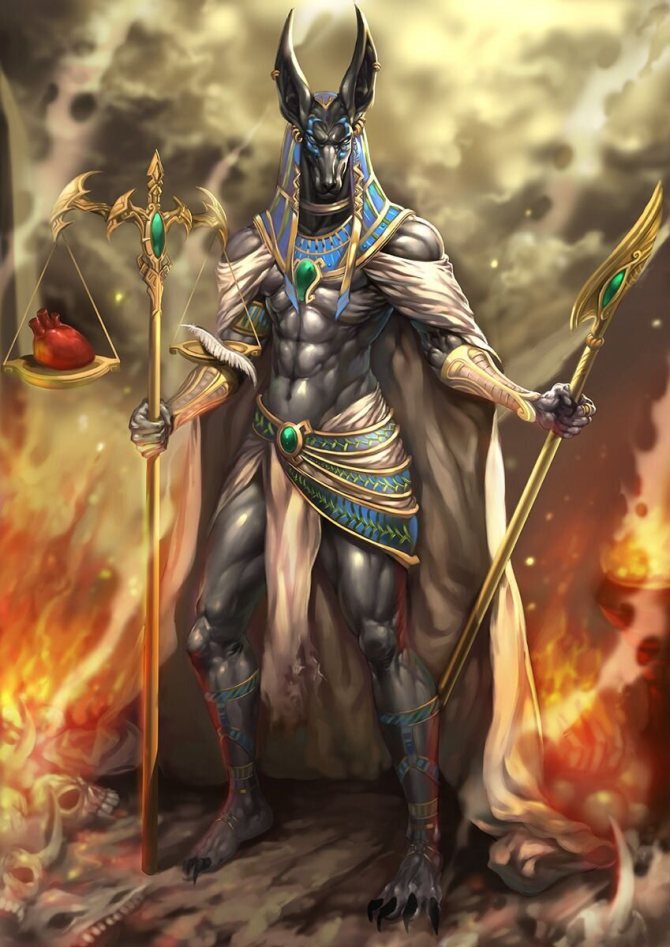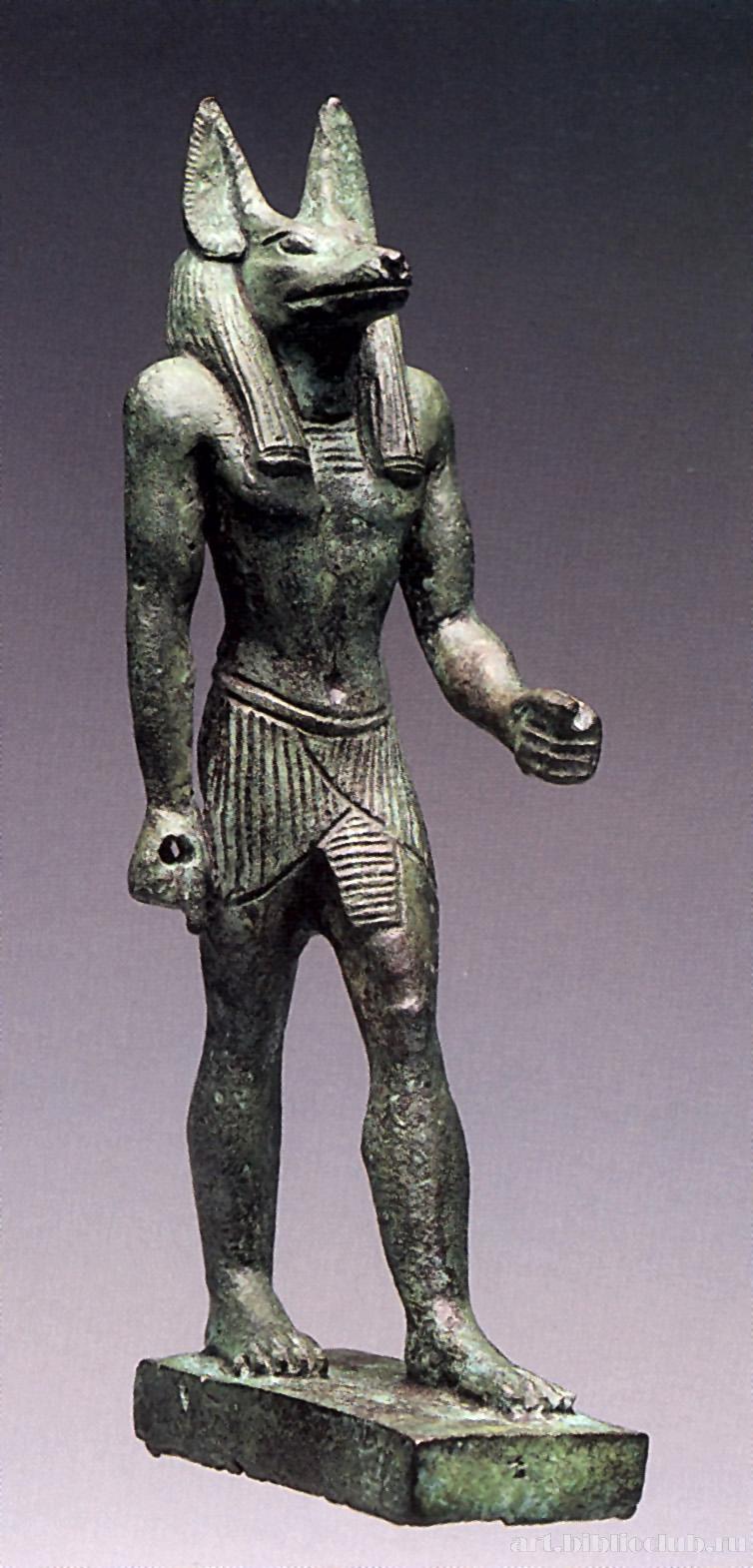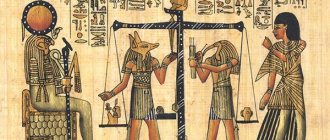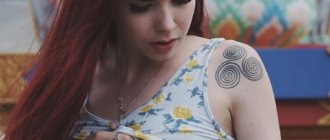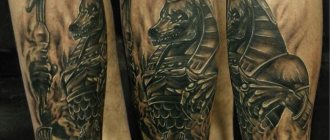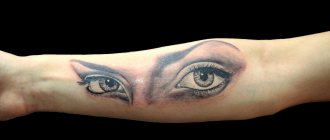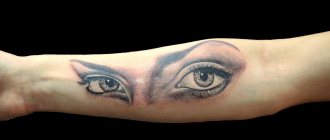Anubis is the ancient Egyptian god who is most closely associated with death, the afterlife and the process of mummification. In ancient Egyptian religion he was depicted mainly as a dog or a man with a dog's head. Anubis played several important roles in ancient Egyptian mythology, including the protection of tombs; leading people to the afterlife and the Weighing of the Heart, an ancient Egyptian concept where your soul is judged. Anubis was one of the most popular deities in ancient Egypt, his cult center being at Sinopolis in Upper Egypt. In keeping with his popularity, he is often depicted in ancient Egyptian art. His most famous statue, the Shrine of Anubis, which was discovered in the tomb of the famous Egyptian pharaoh Tutankhamun. Modern depictions of Anubis in popular culture tend to be inaccurate, depicting him as a satanic figure, while in ancient Egypt he was revered as a rational God. Here are 10 interesting facts about Anubis, including his history; myths; powers; worship and significance in ancient Egypt and depiction in popular culture.
№1. Anubis is depicted with the head of a dog and the body of a man.
As with many gods from the ancient world, there are several variants on the name Anubis, each indicating a different part of evolution. Before the arrival of the Greeks in Egypt in the 7th century B.C., the god we call Anubis today was actually called "Anpu" or "Inpu," which means "to decay," and symbolizes his early association with death. Anubis, then, is the Greek translation of the name. After the Greeks arrived in Egypt and began to influence the area, the Greek god Hermes, "Hermanibus," was also created in the composition of Anubis. Both in the original Egyptian form of Anubis and in the much later Greek-Egyptian composition he is depicted with a dog's head and a human body. For centuries this canine head was usually associated with a jackal. However, recent DNA evidence suggests that the wild canines in the area from which the ancient Egyptians may have drawn inspiration may have been wolf-like.
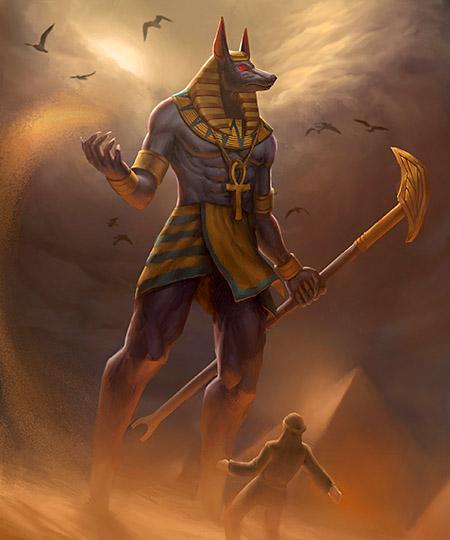
The ancient Egyptian god Anubis.
For men.
Male versions of sketches depicting Anubis symbolize the master's willingness to sacrifice his life for others without hesitation. Demonstrate the balance of light and dark thoughts, the ability to keep under control their dark part of nature. Also, drawings can signify a desire to search for one's life destination, readiness to find the right path or to serve as a talisman and protection. Often this option is the choice of individuals with a complex fate, who believe in a bright future.


№2. His most important role was in "weighing the heart."
Anubis played several roles in ancient Egyptian mythology. He was the protector of graves and cemeteries. Because the dead were usually buried on the west bank of the Nile, Anubis was called hent-imentu, meaning "the foremost of the western inhabitants." Anubis was associated with mummification, because of which he was called jmy-wt, meaning "he who is in the place of embalming." Anubis was most prominently associated with the afterlife. It is here that much of the most common mythology associated with the role of Anubis is touched upon. Anubis guided people from the world of the living to the afterlife. His most famous role, however, was in the Weighing of the Heart. The ancient Egyptians believed that on your journey through the underworld you would enter the "Hall of Maath," where your heart would be measured on a scale opposite to Maath's "pen of truth. Anubis will weigh the heart of a dead person. If the heart is weighed lightly, the soul will be carried into life after death; however, if it is heavier, the Egyptian demoness Ammut will swallow it, and this will be the end of the person's afterlife.


Anubis at the Weighing of the Heart procedure
Colored Tattoos
If you opt for one of the colored images, be sure to discuss this point with the master beforehand. When choosing colors for the tattoo of the Egyptian deity, there are small patterns. Color sketches are performed with the use of black, which symbolizes the afterlife. The white color is associated with the bandages of the mummy. Green, the color of rebirth, blue and red are also used. Yellow emphasizes the golden ornaments of the god and thus demonstrates his greatness.


№3. Anubis was combined with the Greek god Hermes to create Hermanubis.
In some versions of Egyptian mythology, the god Hathor guided souls to the afterlife. However, because of his close association with death and the process by which souls were judged and given access to the afterlife, Anubis began to gain a reputation, in later Egyptian mythology, as the guide of souls. Hermes was a god in ancient Greek religion and mythology, fulfilling several roles, including being the conduit of souls to the underworld. Although Anubis was not a messenger god or a trickster like Hermes, they do share a role in guiding souls into the underworld. This explains the merger of Hermes and Anubis. The fusion occurred after contact with the Greeks and led to the creation of the complex figure of Hermannubis. He is depicted with a human body and the head of a dog, like Anubis, and carrying a sacred staff called a caduceus, like Hermes. Hermanubis was a popular deity during the period of Roman domination of Egypt.
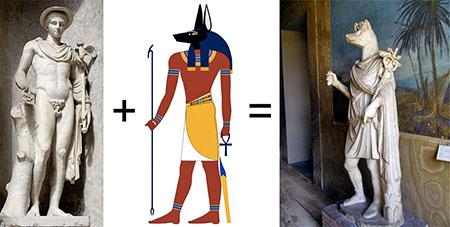

Hermanubis
Anubis and Seth.
In later mythology, Anubis was equated in power with Horus. This is not surprising, for there is even a separate legend that Seth did find the place where Isis was going to resurrect Osiris. However, Anubis not only protected his adoptive mother and father, but also managed to resist Seth, so much so that he even skinned him and then branded him.
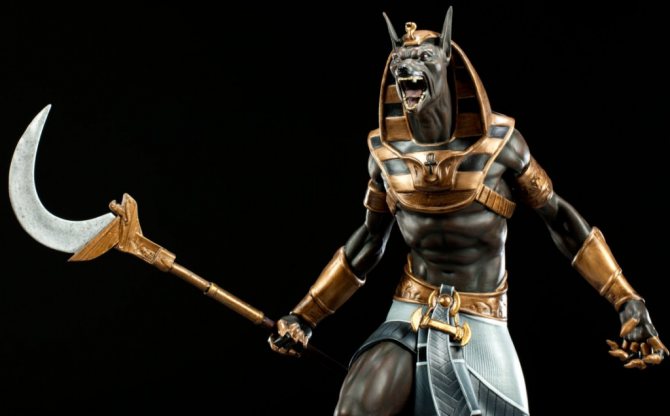

By the way, Egyptian priests were often depicted wearing leopard-skin cloaks. Legend has it that Anubis himself threw the skin of Sera over himself before branding it. By the way, the Egyptians explained the spots on the leopard skin by the fact that these spots are the fiery brand of Anubis.
If the legends are to be believed, Anubis did not crave absolute power at all. He did not take the place of Seth, defeating him, he voluntarily surrendered the reign of the underworld to Osiris. In spite of this, his strength was maddening, for he quickly enough overpowered Seth, while Horus, considered a reincarnation of Ra, was never able to overpower Seth in battle until their fate was resolved by the fateful scales.
№4. His wife is Apnut, and his daughter is Kebechet.
In many forms of ancient mythology, the origins of certain figures are obscured or otherwise altered between different descriptions of the stories, and Anubis is no different in this respect. Different versions give Anubis different origins, which in turn may lead to different interpretations of his general position and location in the ancient Egyptian pantheon. The Egyptian Gods and Goddesses Ra, Hesat, Bastet, Nephthys and Osiris are all offered in various combinations as parents of Anubis. The differences arise depending on whose account is read. In addition, later Greek records, such as Plutarch's history, differ from the classical Egyptian ones. However, regardless of his origins, Anubis' association with death and the underworld remains relatively constant, Anupus' wife is Anput, goddess of funerals and mummification. Their daughter is the serpent goddess Kebechet, goddess of purification.
Anubis and Bastet.
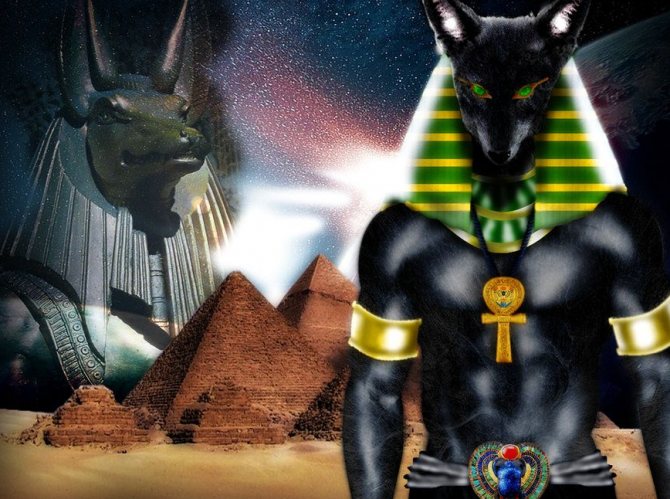

In general, these deities almost never had a disagreement, for they were always on the same side. The only time the gods had a quarrel was when an enraged Anubis growled at Bastet, and this frightened the goddess so much, that she accepted her evil nature - Sekhmet, who, in her time, had almost completely destroyed mankind at Ra's command.
Legends are silent about how this story ended, but both deities, most likely, were "scattered in the corners" by other gods, because fighting with each other they could make a lot of trouble not only for people, but also for gods.
№5. Anubis resurrected the body of Osiris in the myth.
The myth of Osiris is the most influential in the history of ancient Egyptian mythology. Osiris was the son of the earth god Geb and the sky goddess Nut. At the beginning of the myth he rules Egypt, and there is order in the kingdom. However, he is killed by his brother Seth, who is associated with violence and chaos. Osiris' wife, Isis, resurrects her husband's body and bears with him a son named Horus. When Horus becomes an adult, Horus challenges Seth to the throne of Egypt. The conflict ends in Horus' triumph; leading to the restoration of order in Egypt. Anubis plays a role in the myth as an ally of Osiris. In fact, according to the myth, he is the son of Osiris and his daughter-in-law Nephthys. When Osiris dies, it is Anubis who helps resurrect his body. This made Anubis the patron saint of embalmers. Apart from this myth, Anubis does not appear often in ancient Egyptian mythology. Moreover, because he is associated with death, he is often the figure in the myths that looms larger at the end of the story than the one involved everywhere else.
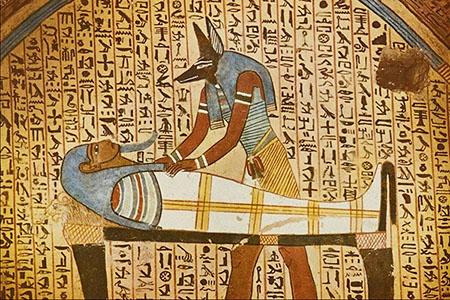

Anubis visits the mummy of Osiris
Meaning
The main message of the tattooed sign is based on the reputation of jackals. The aggressive animals prowled the suburbs of ancient Egypt, where there were necropolises intended for burial. Therefore, in the ancient culture of Egypt, the character of legends was attributed the function of guarding the dead. The living pictures of Anubis reminded of the ban on disturbing the souls of the departed in the other world.
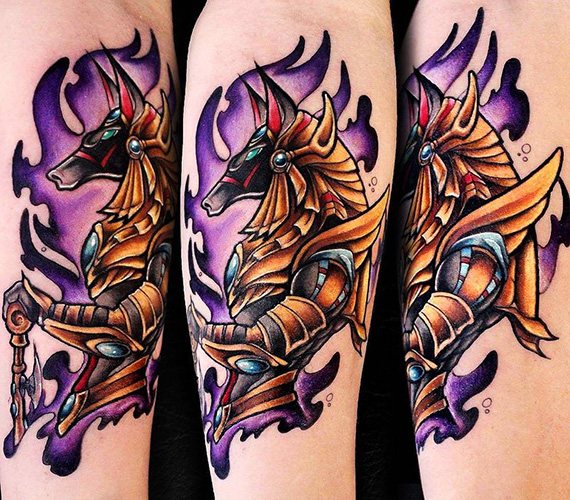

Anubis, tattoos (sketches of the deity with a jackal's head) have another version of interpretation. The mythical hero is called the patron of poisons and medicines, which is associated with the importance of new discoveries and new ways, the movement forward to limitless possibilities. In this case, the tattoo with Anubis becomes a talisman for its bearer, protecting not only from evil, but also from unexpected death.
What does the god pose mean?
Depending on the location of the key figure, the meaning of the tattoo for its owner changes:
- placement of the god facing the world - a calm attitude towards those around him;
- A pose on a half-turn - readiness to interfere in events (if necessary);
- A figure in profile - the position of the observer, protector of souls from evil spirits;
- God standing on one knee - the sign of the decider (in "hell" or "heaven").
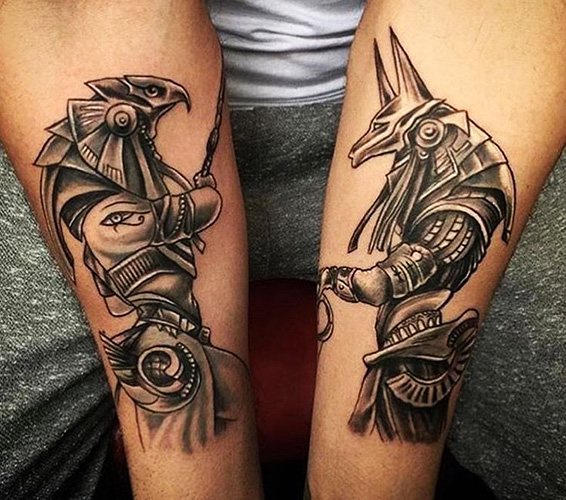

Anubis, a tattoo (sketches of the mystical deity can be drawn independently) - a distinctive sign of a balanced personality. An unusual picture can hide a serious meaning, but also act as an ordinary decorative symbol. It all comes down to what purpose the owner of the tattoo pursued when choosing a sketch.
The influence of the placement
Protective properties of a naked amulet with a pagan symbol acquire a special meaning depending on the place of application:
- A large-scale panel with Anubis armed with attributes will protect the owner of the tattoo from injury. The main character is also placed surrounded by associates in the divine pantheon - Upuat (guide to heaven), Kebhut (the goddess of embalming).
- The blackness of the picture in the spirit of minimalism on the shoulder or forearm symbolizes the strength of the owner, his fearlessness in moving along the curves of the road of life. In addition, the farther the tattoo is located from the brush, the greater the spiritual load finds the image.
- Completely stuffed shin denotes a man following the already acquired path. Anubis, as the patron saint of medicines and poisonous substances, on the calf or shin are printed by people closely associated with medicine (psychiatrists, anesthesiologists).
- The tattooed sign is rather seldom placed in unusual places - on the back of the neck, more often in the solar plexus. These areas are considered to be energy centers on the human body, and the significance of tattoos printed in their place is enhanced.
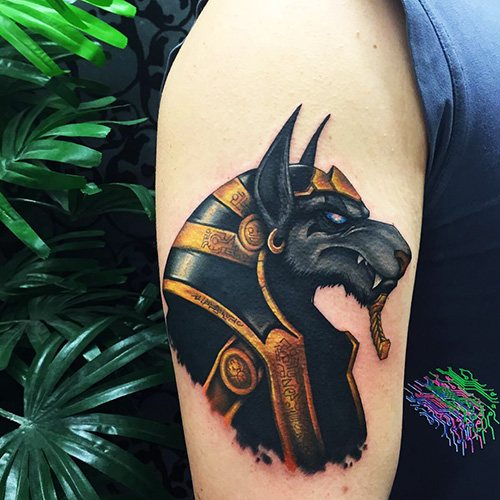

Interestingly, members of the prison population give the Anubis tattoo a very different meaning. The tattoo is chosen by prisoners who are unrepentant of their crime. And it can be people who are serving time on unfairly brought charges.
The meaning of the male tattoo
Anubis, a tattoo (sketches of Anubis - the choice of the most determined connoisseurs of the art of body painting) for men who have decided to find their own key position in life, from the usual predilection for ancient culture turns into a strongest protective sign. Sketches with an ominous figure attract unconventional personalities whose complicated fate has not overshadowed their faith in a better future.
Men's choice of a tattooed Anubis symbolizes:
- Bravery, courage and boldness;
- purity of thoughts of the tattoo owner;
- readiness to accept the verdict of a just judgment;
- reverence for the world of the dead, respect for the memory of the ancestors.


By adding additional symbols to the main character, it is possible to change the semantic load of the entire composition. Such an image on the body of the owner informs others of the unconditional acceptance of the dark side of his soul, which does not prevent him from advancing on the bright path of life. In addition, the dark tattoo can serve as a sign of professional affiliation (psychologists, doctors, pharmacists, lawyers), rather than being a negative stigma.
The meaning of the female pattern
Purposeful girls more often stop at the colored sketches, drawings in the black scale prefer fatalistic fans of tattooing prone to fatalism. On a woman's body, the figure of a deity with a proud posture and penetrating gaze turns into a symbol of wisdom, calmness, calculating. Girls who choose the tattoo of Anubis, try to make the drawing more feminine, to emphasize the sexuality and sophistication of their own nature.
In the subjects of female tattoos, there is a tenderness, and the gloomy hero of the storyline is associated with wisdom and justiceBalance of the bold owner of an unusual tattoo. Fans of ancient Egyptian mythology often stuffed instead Anubis his female counterpart - a slender figure of the goddess Input. The goddess with the head of a dog is considered the guardian of the residence of all the dead.
The mythical character is called the mother of darkness, the mistress of truth, the lord of magic, so the interpretation of her titles is associated with the meaning of the drawing for girls.
The most popular image today recognized the classic version of the tattoo with Anubis, where the human face of the god is crowned with the head of a dog or jackal. The plot of a bright sketch in a minimal color scheme is often complemented by symbols that belong to the otherworld.
Although the meaning of a head painting with Anubis is different for each wearer, the main meaning of the macabre tattoo is protection and protection from injustice. It is a signal to others of punishment for those who offend the wearer of the protective symbolism.
Author: Tatiana Larina
№6. His cult center was Sinopolis in Upper Egypt.
Although he did not appear in many myths, Anubis was an extremely popular God in ancient Egypt. Because the ancient Egyptian paid much attention to death, Anubis gathered his own group of followers dedicated in particular to worshiping him. Since it was Anubis who judged in the afterlife, it was probably believed that worshiping him would lead to the deceased's body being respected after death and his soul being protected in the afterlife. When Anubis prepared the mummy of Osiris in myth, he became the patron of embalmers. In addition, wooden masks made to remind Anubis were used by priests in rituals. Amulets of the god were also common. Sinopolis (Greek for "city of the dog") in Upper Egypt was home to the cult of Anubis. However, there were shrines in ancient Egypt and he was worshipped throughout the country. When the Greeks gained influence in the region, Hermanubis, a fusion of Anubis and the Greek god Hermes, was also widely worshipped.
How to Draw Ra, the Egyptian Sun God
Step 1. We will begin in the drawing guide by blocking in the head shapes . Draw an inverted almond shaped face and then outline the headdress around that.
Step 2. We will draw on the chest as a kind of testicle shape. The abdomen and pelvis a slight twist occurs, so draw the ovaries on the center line. Notice the different curves on the sides of the body.
Step 3. Draw a ball for each shoulder. Then add the shape of the top handle, thick at the top, with narrow curves uniting at the elbow. Draw a diamond for each kneecap. Then draw a large rectangular shape for each hip. One hip goes into a deep corner. Most of the body weight will rest on this leg.
Step 4. Next draw an elongated diamond shape on each forearm, with a hypertrophied curved shape. Add a block for each side of the shape. Lower curve of the legs below the knee, and then a sharp inward turn as they become very tapered toward the ankle. Draw a ball for each ankle and then add a simple leg shape. Extended foot when viewed from the side, so that we can see the arch of the foot.
Step 5. Lighten your Guides, and we begin the final art line. You may need to zoom in to see the details as we begin to work on the face. The first shapes to be extracted from the beak. We are browsing need to be straightforward, so that the shape must be symmetrical. The beak curves down from the top behind the eye sockets, and back up to the cheekbones.
Step 6. We're going to draw some venom-like eye shapes growing out of the beak. Below, we're going to draw the outline of the whole lower jaw section. His mouth will be open, so that's this shape, and in height from top to bottom.
Step 7. Use very thin lines to add detail to the eye areas. With each Curve, we segment the shape of the eye and create more detail. The first up curve creates the eyebrows. Then we add the eyelids, and finally the outline of the eye. On top, we bring the forehead to the peak.
Step 8. Draw the curves inward to create the inner edge of the lower beak. On the top of the beak, we'll add nostrils and some decorative detail on the cheekbones.
Step 9. On the forehead, the crown should have a thin gold rim. Within this shape, we want to draw a simple diagram for the snake body. Inside the mouth, we draw a row of sharp teeth on both the top and bottom. This is where the design gets a little crazy.
Step 10. Add the tongue as a big, lumpy mass inside the mouth. Then add the back teeth to go straight back into the mouth. Draw some thin curves for the eyelids just around the eyeballs. Then add a striped cobra pattern on the forehead.
Step 11. Now we can use bolder lines, giving the head of the dress a more controlled outline. Fabric just above the brow curves of the figure, creating a small crease on each side.
Step 12. Repeat the outline inward, with thinner lines. Then use curves to create a striped running pattern down each side of the headpiece.
Step 13. Here we've briefly outlined the basic shape of the pecs/chest muscles, leaving some space between them in the bosom of the chest. Add a curve for each side of the rib cage. We can also add some curves for the neck muscles.
Step 14. Use the sharp points of each pectoral muscle as a starting point for the biceps Curve. The armpit curve disappears behind the pectoral muscle.
Step 15. Next, we'll focus on simple armor pieces. There are diamond plates on the lower abdomen. Each side of the plate has a similar shape, but cut in half, and we're looking at them from the sides. Use long curves to outline the draped fabric. End each outside line with a block or triangle shape to create where the fabric curves. The inside of the fabric curves in the opposite direction, creating depth.
Step 16. The fabric on the ras of the hip wrinkles perfectly in a down and out pattern. Let's add some detail to the cuffs and hip armor.
№7. Anubis is often represented in ancient Egyptian art.
Anubis was one of the most frequently represented deities in ancient Egyptian art and later in Greco-Egyptian art. Works of art depicting Anubis can be found throughout the history of ancient Egypt. He is the earliest god depicted on tomb walls and called to protect the dead. In pictorial representations, Anubis is usually shown leading the mummification and burial or standing with the other gods at the Weighing of the Heart of the Soul in the Hall of the Two Truths in the afterlife. A popular depiction shows him kneeling with the head of a dog holding a golden scales that are used to weigh the heart. Art depicting or relating to Anubis can be found in museums all over the world. A statue of Anubis with a dog's head and a long wig can be found at the Metropolitan Museum of Art in New York, while a bronze figure of Anubis in bracelets can be seen at the British Museum in London. A statue of Hermanubis, meanwhile, can be found in the Vatican Museums at the Vatican.
For women.
Beautiful ladies, who stop their choice on such a variant of the sketch, may be characterized by a tendency to fatalism. The image of Anubis on a woman's body accentuates the determination of her mistress, serves as a talisman against all impure things, and can demonstrate difficult periods that she had to endure. The sketches also symbolize the absence of fear of difficulties and the ability to overcome them.


№8. Anubis in his animal form guarded Tutankhamun's tomb.
When the famous discovery of the tomb of the Egyptian pharaoh Tutankhamun was made, a temple of Anubis was found among the tombs. A statue of Anubis, depicted entirely in the shape of an animal, was attached to the roof of the temple. It squatted at the entrance. This was because one of the roles of Anubis in ancient Egyptian mythology was to guard the spirits of the dead in the afterlife and to punish mortals who violated the sacred tomb. The jackal-shaped figure of Anubis, made of wood, is just over 3 feet long. It is skillfully carved to show the taut muscles of the canine deity. The life-size statue has gilded ears, collar and scarf. It is also covered with black paint, since black was the symbolic color of Anubis because it represented death and decay. The temple of Anubis is one of the outstanding objects of Tutankhamun's tomb. It is currently on display at the Egyptian Museum in Cairo.
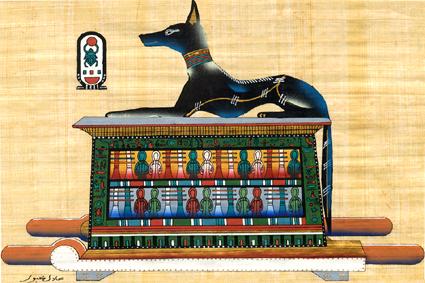

Anubis on the sarcophagus of Tutankhamun
Tattoo of Anubis: meaning
The variant of the tattoo with Anubis is always filled with an energy charge and is considered the embodiment of power. However, what exactly such a drawing can bring to everyone's life remains an unexplored mystery. Anubis is called the most mysterious character of Egyptian culture, hence the variety of tattoo symbols. According to one version, this Egyptian god was a guide to the afterlife and patron of the dead, hence many hold a negative opinion about such a body image and believe that it is able to bring misfortune to its owner.


Another version tells of a deity as the guardian of medicines and poisons, which in the meanings of tattoos can mean the pursuit of the unknown, the movement forward with unlimited possibilities. In addition, many give the image of a god the ability to protect its master from the effects of evil spirits and is considered a talisman against untimely death. The meanings of male and female tattoo designs also have different meanings.


№9. Anubis has the ability to curse those who disturb the dead.
Since Anubis is associated with death and carries the scales on which the heart is weighed in assessing a person's soul, any "supernatural abilities" associated with him are implied rather than explicit. As the protector of the tombs that guarded the body after death, Anubis had the power to cast curses on others, protecting the dead. When Tutankhamun's tomb was discovered, several people who entered the tomb died. This led to a lot of talk about the Curse of Tutankhamun. It is interesting to note that it was Anubis who guarded the pharaoh's tomb. Like Hades in Greek mythology, Anubis is associated with evil deadly powers. The central role Anubis plays in Egyptian conceptions of death, moral judgment, and the afterlife makes him an influential figure in Egyptian mythology.
Anubis and Osiris
So, you already know about the role Anubis played in the one-day resurrection of Osiris. But his role and his reference in Egyptian mythology did not end there. The fact is that when Gore finally overthrew the usurper Seth on the Egyptian throne, all the cards and all the mysteries of the afterlife were revealed to Anubis.
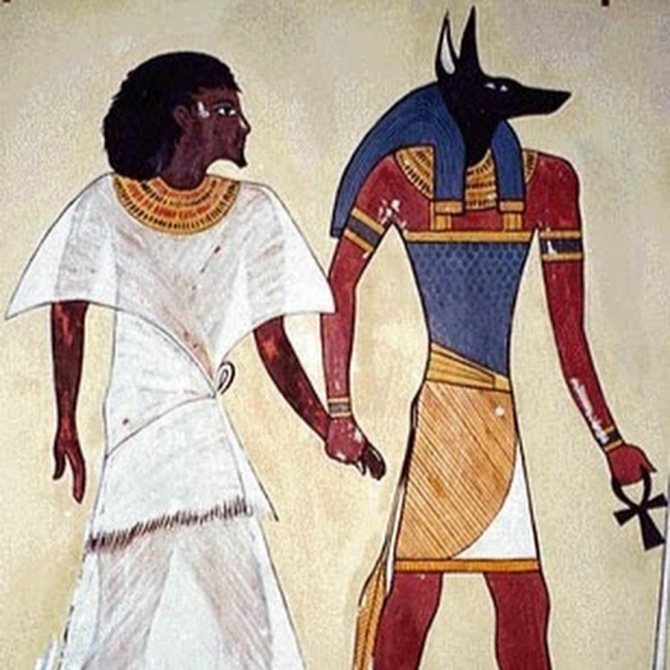

Using his knowledge and skills, Anubis fully resurrects Osiris and offers him his proper place on the throne. Osiris, however, refuses. Instead, he says that he wishes to go again to the realm of the dead, whose ruler he longs to become. No one had any objection to this, so this is what was done. And so Anubis became a full-fledged advisor at the posthumous court, as well as a conduit for souls to the realm of the dead.
Question for the expert.
Why did Anubis stop ruling the world of the dead?
Most likely - he did not need it. If you believe the legend, his power was no less than that of Horus, who was the reincarnation of Ra. Apparently, he was quite satisfied with the role of guide and judge.
№10. Modern depictions of Anubis in popular culture do not correspond to his true image.
In modern representations, Anubis is often at best a fearful, powerful figure; and at worst a villainous one. In the last few decades he has gained popularity in popular culture. These modern depictions often play the role of Anubis as god of the dead and the afterlife in a more aggressive or otherwise evil role than in Egyptian mythology. In classical Egyptian mythology, however, Anubis has a much more moral reputation . He is an ally of Osiris, whose resurrection myth is of great interest to scholars because of its potential influence on other belief systems. Also, while modern pictorials attribute something satanic to Anubis, in fact, in the Egyptian pantheon, his true disposition is much closer to the more reasonable figure who is at the center of Egyptian conceptions of death and the afterlife; and the concept of morality.
Recommended on the subject
How myths originate in the mythology of Mielnir Vanaheim
We wrote about how these two deities were identified by the Greeks and Egyptians in our article. But we never gave you the details. The fact is that in Greek mythology there is a moment (the attack of Typhon) when most of the Olympians withdrew to Egypt, and Hermes is one of those who escaped. Perhaps it was at that time that he became combined with Anubis, since the task of both gods was to escort the souls of the dead to the afterlife. Moreover, the influence of the Greeks on Egyptian history can be felt even in the details. The merger of Anubis and Hermes led to the birth of a new god, Germanubis, who had the qualities of both gods and carried Hermes' caduceus along with his staff.
Wife and Daughter
Mythology tells us that Anubis had a wife and a daughter. The first was called Input, and the second, Kebechet. And while there are no questions about the daughter, there are many about the wife. The fact is that scientists haven't figured out the complex Egyptian mythology yet. Even now, in 2021, we don't know how the Egyptian language actually sounded at the time, and therefore many scientists claim that Input is the original correct pronunciation of the name Anubis, which has come down to us from Greek sources. Incidentally, Input was also considered the goddess of funerals and mummification as a wife.
Amulets
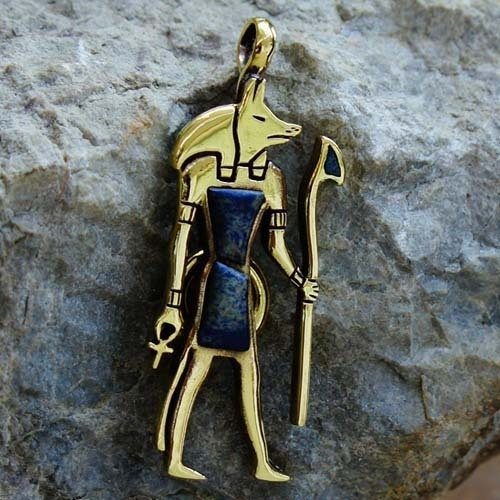

In those ancient times, amulets and amulets were very popular. For the sake of justice, it should be said that amulets were not the only ones with Anubis in use. However, perhaps the amulets and symbols of Anubis were the most popular. Moreover, they were used almost legally by healers and magicians. By the way, the symbols of Anubis have survived until today. For example, nowadays, very popular are the rings with the image of the god-jackal.
The animal incarnation
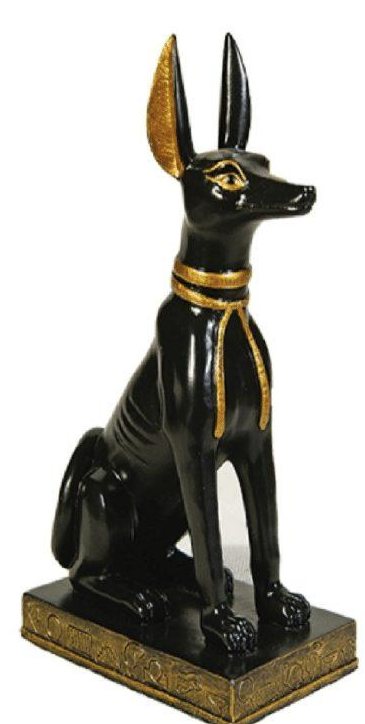

As Bast could transform into a cat and a lioness, so Anubis could transform into a jackal. It was in this form that he guarded the tombs from looters. Anubis was believed to have the power to curse those who disturb the souls of the dead. This is not surprising, because Anubis did not violate the rights of the dead, even though he had to confront the mighty Seth when Anubis first resurrected Osiris.
Incidentally, the temple of Tutankhamun had an image of a full-fledged jackal-Anubis. As you probably know, most of the people excavating the tomb of the young pharaoh died within a couple of days after the opening of the tomb. And these deeds the locals attributed to none other than Anubis.
Not evil.
In today's culture, Anubis very often appears to us as some kind of villain. The influence of the gaming industry and movie industry has led to a situation where most people have no idea what Anubis really means. And yet he was not evil or aggressive at all. Moreover, it is safe to say that he was as fair as possible. Otherwise he would not have been able to approach the scales of justice.
Anubis was known far beyond the borders of Egypt
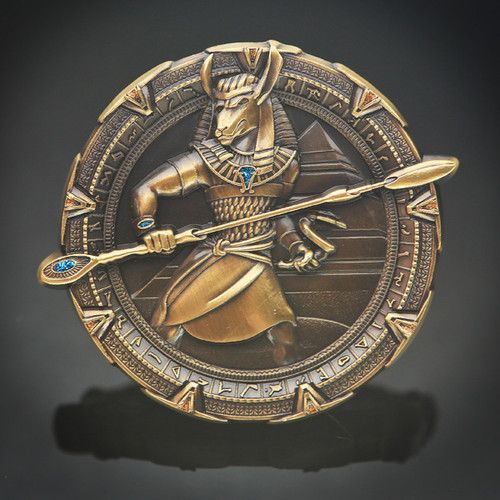

The influence of the cult of Anubis was truly impressive. So much so, in fact, that both the Greeks and Egyptians decided to change the names of their gods-conductors of souls to the realm of the dead and unite them. Besides, Anubis was known even later, during the heyday of the Roman Empire.
By the way, the legend says that Anubis was depicted on the shield of Aeneas, one of the greatest heroes of ancient Greek mythology. According to legend, it was he who led the rescued Trojans to Italy, and it was also he who was the father of Romulus and Remus - the founders of Rome.
White Anubis
Almost always Anubis appears to us as a creature with the body of a man and the black head of a jackal. However, archaeologists have been able to unearth several tablets and statues in which Anubis was depicted in white and green. At this point, history attributes this to the fact that Anubis had something to do with mummification, and that is why similar colors appear in the legends.
This concludes our article, dear readers. We have told you all that is currently known about the greatest god of the world of the dead in ancient Egypt. We hope that you were as interesting to read our article as we were to do it, good luck to all and see you all again.





